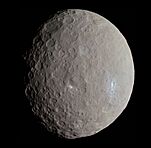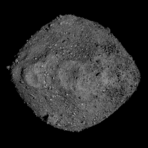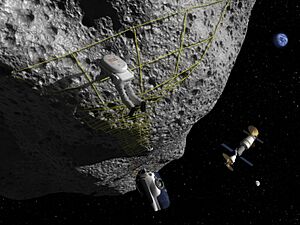Asteroid facts for kids
Asteroids are space rocks that orbit the Sun. Think of them as leftovers from when our solar system was forming. Planets were built from lots of dust and rock. Some of these bits never became part of a planet. These are asteroids!
Asteroids can be tiny, like pebbles, or huge, like mountains. They are made of rock, metal, or ice. Unlike planets, they usually have irregular shapes. Many look like a "rubble pile" instead of a solid ball. Scientists study asteroids to learn about the early solar system. They can give us clues about how planets like Earth were made.
Contents
Where do asteroids live?
Most asteroids live in a special area called the asteroid belt. This belt is found between Mars and Jupiter. It's not a solid ring, but more like a busy highway in space. Millions of asteroids zoom around here. Scientists think over a million asteroids in this belt are bigger than one kilometer (about 0.6 miles).
Some asteroids travel outside the main belt. These are called near-Earth asteroids (NEAs). They have orbits that bring them closer to Earth. Some even cross Earth's path! But don't worry, most are small. They burn up safely in our atmosphere, making beautiful "shooting stars."
What are asteroids made of?
Asteroids are not all the same. Their materials depend on where they formed in the early solar system. Scientists group asteroids into types based on what they are made of. They also look at how much light they reflect.
Here are some common types:
- C-type asteroids: These are the most common, making up about 75% of all known asteroids. They are dark and contain mostly clay and silicate rocks.
- S-type asteroids: These are the second most common. They are brighter than C-types. They are made of silicate materials and some metals.
- M-type asteroids: These are less common. They are mostly made of metal, like iron and nickel.
How big are asteroids?
Asteroids come in many different sizes. Some are just a few meters wide. Others are hundreds of kilometers across. The largest asteroid in the main belt is Ceres. It is about 946 kilometers (588 miles) wide. Ceres is so big that it is also called a dwarf planet!
The three largest objects in the asteroid belt are Ceres, Vesta, and Pallas. These are like mini-planets. They are different from most asteroids, which have irregular shapes. The fourth-largest asteroid is Hygiea. These four largest asteroids make up half the total mass of the asteroid belt.
How do we study asteroids?
Scientists use telescopes on Earth and in space to study asteroids. They look at the light from asteroids to learn what they are made of. They also track their orbits. Sometimes, spacecraft are sent to visit asteroids up close! These missions can take pictures and even collect samples.
For example, the NEAR Shoemaker spacecraft visited the asteroid Eros in 2001. It orbited Eros and even landed on it. This mission sent back amazing information. Another mission, OSIRIS-REx, collected a sample from the asteroid Bennu. This sample is being brought back to Earth for scientists to study.
Are asteroids dangerous?
Most asteroids are not a threat to Earth. However, some near-Earth asteroids could come close to our planet. Scientists watch these asteroids all the time. They want to know if there is any risk of a collision.
If an asteroid were on a path to hit Earth, there are ideas to stop it. One idea is to use a spacecraft to gently push the asteroid off course. This would keep our planet safe. In September 2022, the Double Asteroid Redirection Test (DART) spacecraft successfully changed the orbit of a non-threatening asteroid called Dimorphos by crashing into it. This was a test to see if we could protect Earth in the future.
History of asteroid discoveries
The first asteroid, Ceres, was found on January 1, 1801. It was discovered by Giuseppe Piazzi, an Italian astronomer. This was the start of many more discoveries. Since then, thousands of asteroids have been found. New ones are still being found all the time. This is thanks to powerful telescopes and new ways to find them.
The first close-up look at an asteroid was by the Galileo spacecraft. Later, NASA and JAXA sent special missions just to asteroids. When a new asteroid is found, it gets a temporary name. Once its orbit is confirmed, it gets a number. It can also be given a name, like 433 Eros.
Asteroid mining
Imagine getting valuable materials from space! The idea of asteroid mining started in the 1970s. Asteroids might have materials that are rare on Earth. They could also provide materials to build space habitats. Heavy materials are expensive to launch from Earth. So, mining them from asteroids could be cheaper for building things in space.
For example, water ice found on asteroids could be used as fuel for spacecraft. This would help us explore space even more. Some scientists also think that if advanced alien civilizations existed long ago, they might have mined asteroids. Looking for signs of this could help in the search for extraterrestrial intelligence (SETI).
Interesting facts about asteroids
- Most of the known asteroids are in the main asteroid belt. This is between the orbits of Mars and Jupiter.
- All the asteroids put together have only about 3% of the mass of Earth's Moon.
- Most asteroids in the main belt have stable, slightly oval-shaped orbits. They orbit the Sun in the same direction as Earth. It takes them three to six years to go around the Sun once.
- As of April 2022, over 1.1 million asteroids had been found. About 614,000 of these had enough information to be given official numbers.
- Asteroids get darker and redder over time. This is due to something called "space weathering."
Images for kids
-
Artist's impression shows how an asteroid is torn apart by the strong gravity of a white dwarf.
-
Asteroid 6481 Tenzing, center, is seen moving against a background of stars in this series of images taken by the James Webb Space Telescope's instrument NIRCam
-
Frequency of bolides, small asteroids roughly 1 to 20 meters in diameter impacting Earth's atmosphere
See also
 In Spanish: Asteroide para niños
In Spanish: Asteroide para niños
- Exoasteroid
- List of minor planets
- List of exceptional asteroids
- List of asteroid close approaches to Earth
- Lost minor planet
- Meanings of minor-planet names


























